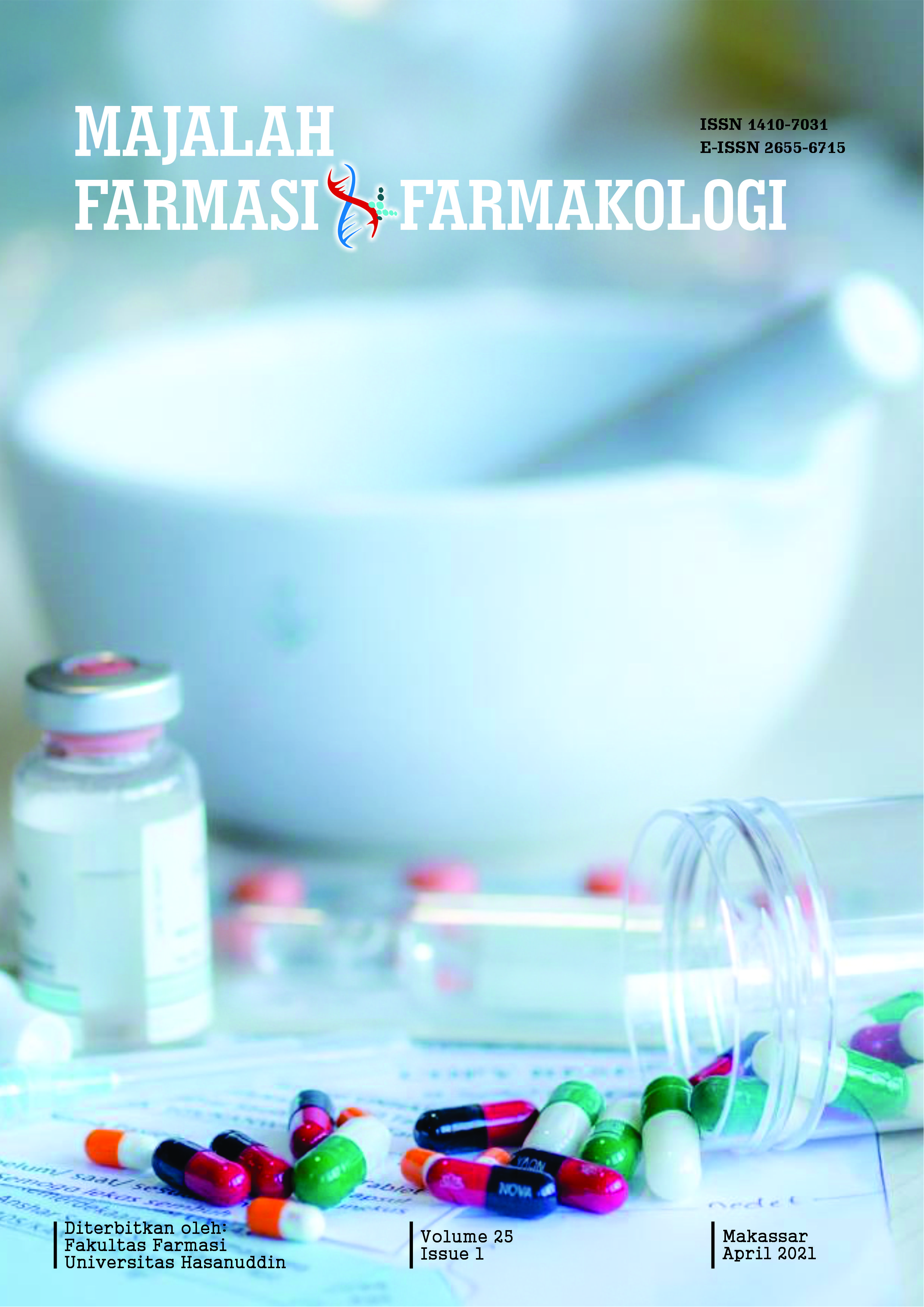EFEKTIVITAS SARILUMAB SEBAGAI KANDIDAT OBAT COVID19: SEBUAH KAJIAN SISTEMATIK
Keywords:
Sarilumab, COVID-19, Sars-Cov-2, penghambat reseptor IL-6, Kajian SistematikAbstract
Penelitian ini bertujuan untuk mengetahui efektivitas dan keamanan penggunaan Sarilumab pada pasien COVID-19 berdasarkan kajian sistematik dari berbagai artikel penelitian yang telah dipublikasikan. Kajian sistematis ini disusun berdasarkan guideline PRISMA (Preferred Reporting Items for Systematic Reviews and Meta-Analyses). Studi yang diterbitkan setelah Desember 2019 dari database PubMed/MEDLINE dan EMBASE ditelusuri secara sistematis. Kombinasi kata kunci seperti "COVID-19”, "severe acute respiratory syndrome coronavirus 2”,dan "Sarilumab" digunakan untuk mencari artikel yang sesuai kriteria inklusi. Dari hasil penelusuran dan skrining artikel, diperoleh dua artikel yang memenuhi syarat kriteria inklusi yaitu satu artikel berupa laporan kasus dan satu artikel berupa seri kasus yang menunjukkan potensi sarilumab dalam pengobatan COVID-19. Pada artikel seri kasus, jumlah pasien yang terlibat sebanyak 8 orang yaitu 6 laki-laki dan 2 wanita dengan kondisi akhir tujuh pasien keluar lebih cepat dari perawatan di rumah sakit (dalam waktu 14 hari) karena telah memperlihatkan hasil negatif pada tes molekuler dan satu pasien yang berusia 83 tahun meninggal pada hari ke-13 di rumah sakit. Pada laporan kasus, pasiennya hanya 1 orang laki-laki dengan kondisi akhir pasien sembuh (hasil tes swab negatif) dan kondisi klinik yang baik. Sebagai kesimpulan, sarilumab berpotensi memberikan perbaikan klinis terhadap pasien COVID-19. Akan tetapi, karena kedua artikel tersebut memiliki kualitas bukti ilmiah yang lemah maka belum bisa dijadikan dasar rujukan penggunaan sarilumab untuk pasien COVID-19 di klinik.
References
DAFTAR PUSTAKA
Jiang, Fang et al. 2020. “Review of the Clinical Characteristics of Coronavirus Disease 2019 (COVID-19).” Journal of general internal medicine vol. 35,5: 1545-1549. doi:10.1007/s11606-020-05762-w
World Health Organization, 2020, Data Collection. Diakses 6 Juni 2020. https://covid19.who.int/
Tobaiqy, M. et al. 2020. “Therapeutic management of patients with COVID-19: a systematic review.” Infection Prevention in Practice vol. 2,3 : 100061. doi:10.1016/j.infpip.2020.100061
Senanayake, Suranga L. 2020 “Drug repurposing strategies for COVID-19.” Future Drug Discovery vol. 0,0): fdd-2020-0010. doi:10.4155/fdd-2020-0010
Senger, Mario. 2020. COVID-19: drug repurposing and new insights for drug discovery. 10.1590/0074-02760200254.
Kato, S., & Kurzrock, R. 2020. Repurposing Interleukin-6 Inhibitors to Combat COVID-19. Journal of Immunotherapy and Precision Oncology, 3(2), 52-55. http://dx.doi.org/10.36401/jipo-20-11 Retrieved from https://escholarship.org/uc/item/5ft476n6
Jiancheng Zhang, et.al, 2020. “Current status of potential therapeutic candidates for the COVID-19 crisis,Brain, Behavior, and Immunity”, Volume 87, , Pages 59-73, ISSN 0889-1591, https://doi.org/10.1016/j.bbi.2020.04.046. http://www.sciencedirect.com/science/article/pii/S0889159120305894
Sanofi-and-Regeneron, 2020, Diakses 16 Maret 2020.
Siswanto. 2010. "Systematic review sebagai metode penelitian untuk mensintesis hasil-hasil penelitian (sebuah pengantar)." Buletin Penelitian Sistem Kesehatan 13.4: 21312.
Gopalakrishnan, S, and P Ganeshkumar. 2013. “Systematic Reviews and Meta-analysis: Understanding the Best Evidence in Primary Healthcare.” Journal of family medicine and primary care vol. 2,1: 9-14. doi:10.4103/2249-4863.109934.
David Moher,et.all, 2015, Preferred reporting items for systematic review and meta-analysis protocols (PRISMA-P) 2015 statement.
Joannabriggs.org. 2017. The Joanna Briggs Institute Critical Appraisal tools for use in JBI Systematic Reviews. https://joannabriggs.org/sites/default/files/201905/JBI_RCTs_Appraisal_tool2017_0.pdf
Ouzzani, Mourad, et al. 2016 "Rayyan-a web and mobile app for systematic reviews. Systematic Reviews, 5, 210."
Benucci, et al, 2020, COVID‐19 pneumonia treated with Sarilumab: A clinical series of eight patients, J Med Virol, DOI: 10.1002/jmv.26062
Di Giambenedetto, et al, 2020, SARS-CoV-2 infection in a highly-experienced person living with HIV, Wolters Kluwer Health, DOI: 10.1097/QAD.0000000000002572
Shengyu Zhang,et.all, 2020, Rational Use of Tocilizumab in the Treatment of Novel Coronavirus Pneumonia, Clinical Drug Investigation (https://doi.org/10.1007/s40261-020-00917-3)
J.-M. Michot , L. Albiges, et.all, 2020, Tocilizumab, an anti-IL-6 receptor antibody, to treat COVID-19-related respiratory failure: a case report, Elsevier Ltd. https://doi.org/10.1016/j.annonc.2020.03.300
Christina C. Price, et all, 2020, Tocilizumab Treatment for Cytokine Release Syndrome in Hospitalized COVID-19 Patients Survival and Clinical Outcomes, CHEST-20-2148.
Satish Tadepalli,et all, 2020, The Role of Interleukin-6 Inhibitors in the Treatment of COVID-19 Infections: A Case Series, Cureus DOI: 10.7759/cureus.8631,
Jared Radbel, 2020, Use of Tocilizumab for COVID-19- Induced Cytokine Release Syndrome A Cautionary Case Report, Elsevier https://doi.org/10.1016/j.chest.2020.04.024
Downloads
Published
Issue
Section
License
Copyright (c) 2021 Majalah Farmasi dan Farmakologi

This work is licensed under a Creative Commons Attribution-NonCommercial 4.0 International License.
The copyright to this article is transferred to Universitas Hasanuddin (UNHAS) if and when the article is accepted for publication. The undersigned hereby transfers all rights in and to the paper including without limitation all copyrights to UNHAS. The undersigned hereby represents and warrants that the paper is original and that he/she is the author of the paper, except for material that is clearly identified as to its original source, with permission notices from the copyright owners where required. The undersigned represents that he/she has the power and authority to make and execute this assignment.
We declare that:
- This paper has not been published in the same form elsewhere.
- It will not be submitted anywhere else for publication prior to acceptance/rejection by this Journal.
- A copyright permission is obtained for materials published elsewhere and which require this permission for reproduction.
Furthermore, I/We hereby transfer the unlimited rights of publication of the above-mentioned paper in whole to UNHAS The copyright transfer covers the exclusive right to reproduce and distribute the article, including reprints, translations, photographic reproductions, microform, electronic form (offline, online) or any other reproductions of similar nature.
The corresponding author signs for and accepts responsibility for releasing this material on behalf of any and all co-authors. This agreement is to be signed by at least one of the authors who have obtained the assent of the co-author(s) where applicable. After submission of this agreement signed by the corresponding author, changes of authorship or in the order of the authors listed will not be accepted.


